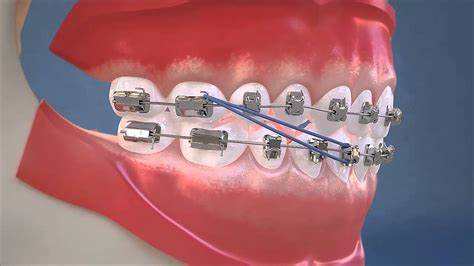Class 4 orthodontics, also known as severe skeletal Class 4 malocclusion, is a complex dental condition that requires specialized attention and treatment. In this article, we will explore what Class 4 orthodontics entail, the impact of severe malocclusion on dental health, and the treatment options available, including considerations for patients with dental implants.
What Are Class 4 Orthodontics
Class 4 malocclusion is a term used in orthodontics to describe a severe misalignment of the teeth and jaws. It is characterized by a significant overbite, where the upper front teeth overlap the lower front teeth excessively. This condition is often associated with skeletal discrepancies, meaning the upper and lower jaws may not align properly.
see also: What Is The Maximum Lifespan of Orthodontic Treatment?
Causes of Class 4 Malocclusion
Several factors can contribute to the development of Class 4 malocclusion, including:
Genetics: Inherited traits play a significant role in dental and skeletal development. Individuals with a family history of severe malocclusion may be more prone to Class 4 orthodontics.
Jaw Growth: Irregular growth patterns of the upper and lower jaws can result in misalignments that lead to Class 4 malocclusion.
Habits: Prolonged habits such as thumb sucking or tongue thrusting can impact dental alignment, contributing to malocclusion.
Missing Teeth: Gaps in the dental arches due to missing teeth can disrupt the natural alignment of surrounding teeth and jaws.
Impact of Class 4 Orthodontics on Dental Health
Severe malocclusion, such as Class 4 orthodontics, can have several implications for dental health:
Difficulty Chewing: Misaligned teeth can make chewing and biting challenging, leading to inefficient food breakdown and digestion.
Speech Problems: Overlapping teeth and jaw discrepancies can affect speech clarity and pronunciation.
Increased Risk of Dental Issues: Class 4 malocclusion can contribute to oral health problems such as tooth decay, gum disease, and temporomandibular joint (TMJ) disorders.
Aesthetic Concerns: The appearance of a severe overbite can impact facial aesthetics and confidence.
Diagnosis of Class 4 Orthodontics
Diagnosing Class 4 orthodontics requires a comprehensive evaluation by a qualified orthodontist. Diagnostic tools may include:
Clinical Examination: The orthodontist will visually assess the alignment of the teeth and jaws, noting any irregularities or asymmetries.
X-rays: Dental x-rays provide detailed images of the teeth, jaws, and facial structure, helping to evaluate the severity of malocclusion and underlying skeletal issues.
Impressions or Digital Scans: Dental impressions or digital scans may be taken to create models of the teeth and jaws for further analysis and treatment planning.
Treatment Options for Class 4 Orthodontics
Addressing severe malocclusion like Class 4 orthodontics often requires a multi-disciplinary approach and may include the following treatment options:
Orthodontic Braces: Traditional braces with brackets and wires are effective in gradually moving misaligned teeth into proper alignment.
Functional Appliances: These appliances, such as headgear or Herbst appliances, are used to modify jaw growth and position, especially in cases of skeletal Class 4 malocclusion.
Surgical Orthodontics: For severe skeletal discrepancies, surgical intervention may be necessary to reposition the jaws and achieve optimal alignment. This may involve orthognathic surgery performed in collaboration with an oral and maxillofacial surgeon.
Combined Orthodontic and Implant Treatment: In some cases, patients with dental implants may require orthodontic treatment to address malocclusion issues. Collaboration between the orthodontist and implantologist is essential to develop a coordinated treatment plan that ensures the stability and longevity of dental implants during orthodontic therapy.
Considerations for Patients with Dental Implants
Patients with dental implants who require orthodontic treatment for Class 4 malocclusion should consider the following:
Implant Stability: The stability and integration of dental implants must be carefully assessed before initiating orthodontic treatment. Any concerns regarding implant health should be addressed and resolved before orthodontic procedures begin.
Treatment Planning: A comprehensive treatment plan should be developed in collaboration between the orthodontist and implantologist. This plan should consider the positioning of implants, potential impact of orthodontic forces on implants, and strategies to minimize risks to implant health during treatment.
Monitoring and Maintenance: Regular monitoring and maintenance of dental implants during orthodontic treatment are essential. Patients should adhere to recommended oral hygiene practices, attend follow-up appointments, and report any concerns or discomfort promptly.
Benefits of Treating Class 4 Orthodontics
Effective treatment of Class 4 orthodontics offers numerous benefits, including:
Improved Oral Health: Properly aligned teeth are easier to clean, reducing the risk of dental issues such as cavities and gum disease.
Enhanced Function: Correcting severe malocclusion can improve chewing efficiency, speech clarity, and overall oral function.
Aesthetic Enhancement: Aligning the teeth and jaws can enhance facial aesthetics, smile harmony, and self-confidence.
Prevention of Complications: Addressing Class 4 orthodontics early can prevent potential complications such as TMJ disorders and dental wear.
Conclusion
Class 4 orthodontics represent a severe form of malocclusion that requires specialized diagnosis and treatment. Patients with dental implants who also have Class 4 malocclusion should seek care from experienced professionals who can develop a tailored treatment plan that addresses both orthodontic and implant-related concerns. By addressing severe malocclusion effectively, patients can achieve improved oral health, function, and aesthetics, leading to a better quality of life.

